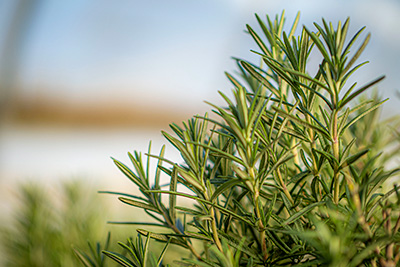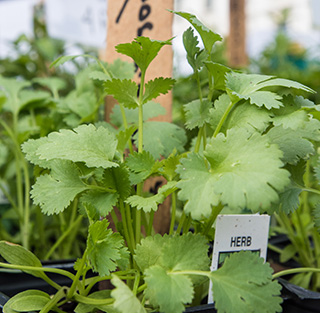Five Fall Herbs for the Home Garden
In Florida, gardeners can plant edibles throughout the year, and fall is a great time to plant an herb garden.
There are many perennial herbs that can be started this time of year, including the ever-popular sage and thyme. There are also some great annual herbs that can be planted now, like cilantro and parsley. Here’s more on our fall favorites.
Rosemary

Rosemary (Salvia rosmarinus) is a pungent, evergreen herb that’s great for cooking and very easy to grow. The narrow, needle-like leaves emit a sharp, somewhat pine-like aroma when crushed. You can use them fresh in meals or dry them for later use.
Rosemary is also an attractive, drought-tolerant plant that works well in containers and landscape beds. It typically grows as a woody perennial or small shrub and can reach up to 6 feet tall and 4 to 5 feet wide. This Florida-Friendly plant will thrive year-round, although it may need to be protected from freezes in colder areas of the state.
This plant is originally from the Mediterranean, so it prefers dry conditions and suffers when watered too frequently. Rosemary demands a well-drained soil and at least six hours of sun.
Sage
Sage (Salvia officinalis) is one of the classic herbs that chefs use when seasoning turkey and other poultry. You can buy dried or fresh sage at the grocery store, but it’s also easy to grow your own.

The quickest way to get started is to buy transplants at your local garden center, but you can start sage from seeds or cuttings anytime from fall through spring. Be sure to choose a spot that gets plenty of sunlight, and don’t forget to provide water as the plant needs it. As your sage grows, it will mature into a semi-woody perennial that reaches 12 to 18 inches tall.
You might even consider planting your sage in a landscape bed instead of a vegetable or herb garden, since its small, silvery leaves make a nice backdrop for other plants.
Thyme
Native to the Mediterranean, thyme (Thymus vulgaris) is a small, perennial shrub with tiny gray-green leaves. Like most herbs, thyme does best in full sun, and it tolerates drought well. It can be planted by seed in either late fall or early spring. Make sure to plant in good-draining soil. To use, remove the top one-third portion of the plant when in full bloom and spread on newspaper in a well-ventilated room to dry. Then, strip the leaves and flowering tops from the stem and store in tightly closed containers.

Cilantro
Cilantro (Coriandrum sativum) is a bright green annual plant with many culinary applications. This flat, feathery-leafed herb is often used in Latin American and Southeast Asian cooking. It can add a fresh flavor to many dishes, including salsa. Cilantro’s flavor is similar to parsley, though it’s a bit more tangy.
You can start cilantro from seed or purchase transplants. This herb will do best in an area with full sun to part shade and rich, well-drained soil.
And here’s a fun fact: technically, cilantro is the same herb as coriander. When the leaves of the plant are used as a seasoning, it’s known as cilantro. When the seeds are used, it’s called coriander.
Parsley
Parsley (Petroselinum crispum) is a versatile herb that comes in both curly and flat-leaf forms, with the flat-leaf having the strongest flavor. Here in Florida, the time to plant parsley is in late fall or early winter. You can purchase transplants or start your own plants from seed. The seeds can be slow to germinate, so soak them in water overnight before planting. Being a cool-season plant, parsley may start to fade when hot weather arrives.
And here’s a fun fact you may not know about parsley—it’s also a host plant for caterpillars of the black swallowtail butterfly. So even if you don’t cook with it, the caterpillars will appreciate your parsley plant.
